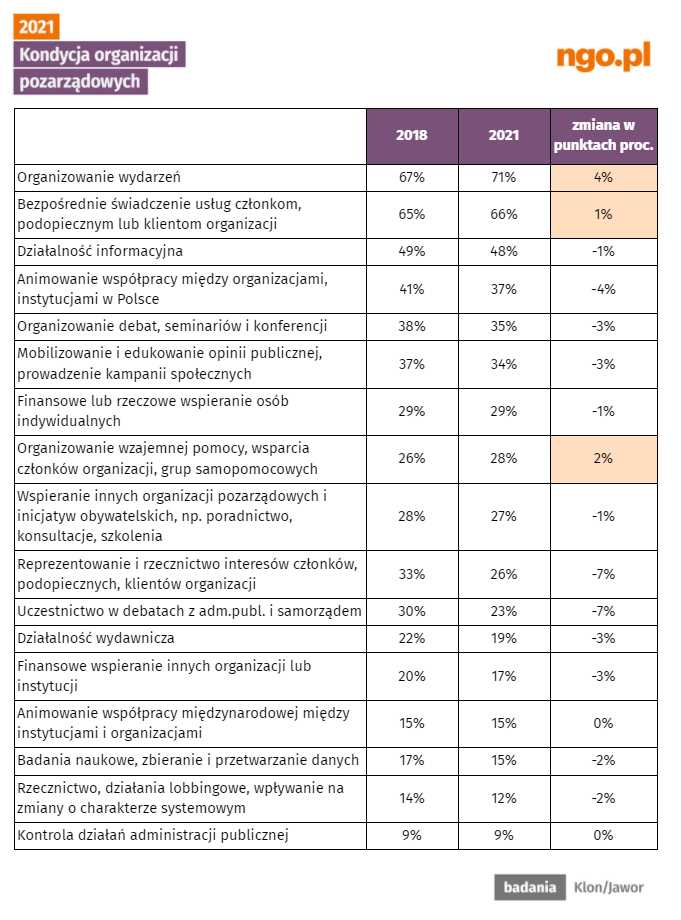Katalog kursów i poradników edu.ngo.pl na 2026 rok Zawsze pod ręką. Pobierz >
The condition of NGOs in 2021. NGOs branch out and are more likely to provide services
What do foundations and associations in Poland deal with? Very many topics, as most organizations are multidisciplinary - they don't focus on just one area, and on average list about three different issues that they address in their activities. What are the most popular areas of activity? What changes are observed in the forms of NGO activity over the past few years? Are organizations pulling back from advocacy and focusing more on providing direct services to their recipients?
There are 70 thousand non-governmental organizations actively operating in Poland. In the REGON register we find many more associations and foundations, as many as 138 thousand (not including Volunteer Fire Brigades). However, not all registered organizations actually carry out activities - according to the Central Statistical Office, about 50 percent of those listed in the register are active. Conducting a survey of a representative sample of associations and foundations gave us an insight into the situation of NGOs in Poland and the key challenges they face.
What do NGOs do?
Let's start with a basic question - what do NGOs do? We can answer this question by referring to the areas in which the organizations operate and by taking a closer look at how they do it. Let's start with the areas.
At the outset, a caveat should be made that most organizations do not deal with only one area; a single organization indicates an average of 2.7 areas as those in which they undertake some activity. Such a combination of several subject areas in their activities is characteristic of NGOs and is most likely a result of both pragmatic reasons and the NGO's mission.
The proportion of organizations dealing with particular topics has not changed significantly over the years. The largest number of organizations, more than half (54%), operate in the area of sports, tourism, leisure and hobbies, e.g. conducting sports activities, organizing recreational events. Many school sports clubs and local associations operate in this manner. However, many NGOs conduct sports activities in addition to other, primary activities (e.g., in the area of health care).
More activity in the field of education
More than half of the organizations (51%) are engaged in education, at different levels: preschool, school, but also dealing with higher education, adult education or conducting extracurricular, educational activities. Compared to 2018, the number of organizations engaged in education has increased. Perhaps this is due to the pandemic, when many organizations that previously did not specialize in this topic began to support remote education.
One in three organizations (34%) undertake activities in the area of culture and the arts, and one in five (19%) is involved in health care. This includes prevention, health education, as well as conducting treatment, distributing medicines and medical equipment. Interestingly, despite the pandemic, we have not seen an increase in the activity of organizations in the health sector.
Ecology and national identity growing in popularity
A few more developments are worth noting. Between 2018 and 2021, there was an increase in the number of organizations operating in the field of ecology and environmentalism, such as those engaged in education on sustainable development and activities to raise awareness of the threat of the climate crisis.
Another increase, albeit a slight one, has been observed in the percentage of organizations working in the area of maintaining and disseminating national identity. Although this includes both activities for national and ethnic minorities and regional languages, as well as nurturing Polish culture and the development of national, civic and cultural awareness, the latter category (nurturing Polishness) is by far the most prevalent among the organizations operating in this field.
A similar increase to that recorded in "maintaining national identity" is also observed in the areas of "international activities" and "religion".
All the areas in which the NGOs operate, as well as the changes in their activity in each area over the past three years, are presented in the table below.
The table description - condition of NGOs
Left column
sports, tourism, leisure, hobbies
education
culture and arts
health care
social services
local development
environment protection, ecology
sustaining national identity
supporting institutions, NGOs and citizen initiatives
scientific research
labor market, employment, inclusion
law, human rights, political activity
international activity
professional groups, workers’ rights, industry issues
religion
defense, security, rescue services
other activities
Right column heading
change in percentage pts
Not only multiple areas
NGOs operate in multiple areas. However, when asked about the primary field in which the organization operates, the results are as shown in the table below. Regarding the organization's main field of activity, rather little change has been observed over the past few years.
35% of organizations declare that "sports, tourism, leisure, hobbies," as their main field of operation, 15% specialize in culture and arts, and 14% in education.
The following table shows some of the organization's largest areas of (primary) activity. Other areas contribute 2% or less (each) to the overall picture.
The table description - condition of NGOs
Left column
sports, tourism, leisure, hobbies
culture and arts
education
social services
health care
local development
environment protection, ecology
sustaining national identity
Right column heading
change in percentage pts
Events and services for beneficiaries
Regardless of the area in which an organization operates, it can achieve its goals in different ways, in different forms. The most popular form of an NGO's activity is organizing events: e.g. concerts, festivals, tournaments, etc. - 71% of organizations do this (4 percentage points more than in 2018). This increase may be puzzling in the context of pandemic-related restrictions making it difficult to organize "live" events. On the other hand, as a side-effect of the pandemic, various types of online events have proliferated, and perhaps this is the reason for the greater popularity of this form of operating for NGOs.
Two out of three NGOs (66%) directly provide services to members, wards or clients of the organization, and half of the NGOs (48%) conduct outreach activities.
Other forms of activities of associations and foundations include promoting cooperation between organizations and/or institutions in Poland, e.g. initiating joint actions, meetings (37%), organizing debates, seminars and conferences (35%), mobilizing and educating the public in support of the organization's activities, running social campaigns (34%) and financial or in-kind support of individuals (29%).
Less advocacy
About one in four organizations say they represent and advocate for the interests of their members, wards, or participate in debates with public administration and local government, such as through participation in public consultations, campaigns, protests. These two forms of activities recorded a decline of 7 percentage points compared to 2018, when about one in three NGOs conducted such activities.
In contrast, one in eight organizations conducts advocacy, lobbying activities, influences systemic changes, such as working to change laws. This type of activity also saw a decline, albeit a smaller one (two percentage points).
The table description - condition of NGOs
Left column
Organizing events
Direct provision of services to members, wards or clients of the organization
Outreach activities
Promoting cooperation between organizations and/or institutions in Poland
Organizing debates, seminars and conferences
Mobilizing and educating the public in support of the organization's activities, running social campaigns
Financial or in-kind support of individuals
Organizing mutual help, support for NGO members, self-help groups
Supporting other NGOs and civic initiatives, e.g. guidance, consultations, training
Representing and advocating for the interests of members, wards or clients of the organization
Participating in debates with public administration or local government
publishing
Supporting other organizations or institutions financially
Promoting international cooperation between institutions and/or organizations
Scientific research, data collection and processing
Advocacy, lobbying, influencing systemic changes
Monitoring the activities of public administration
Right column heading
change in percentage pts
A permanent shift toward direct action?
One may wonder to what extent the change in NGO modes of operation is conscious and deliberate. The data shows that only three forms of activities have seen an increase in the last three years out of a list of 17 different forms. These are: organizing events, providing a direct service to beneficiaries, and organizing mutual aid/support for organization members.
Organizations are therefore more likely to focus on direct action for members or beneficiaries of their activities. In turn, they are withdrawing from advocacy activities, less likely to enter into discussions with local governments or public administration, or to take action for systemic change.
It is difficult to determine how sustainable this change is. Perhaps it is related to the current socio-political situation, as well as the steady decline in opportunities for dialogue between organizations and the authorities or the accessibility of decision-making processes. As a result, organizations are focusing on their immediate environment, acting directly with their target demographics, and consciously abandoning systemic measures, not seeing the possibility of introducing them at the moment.



